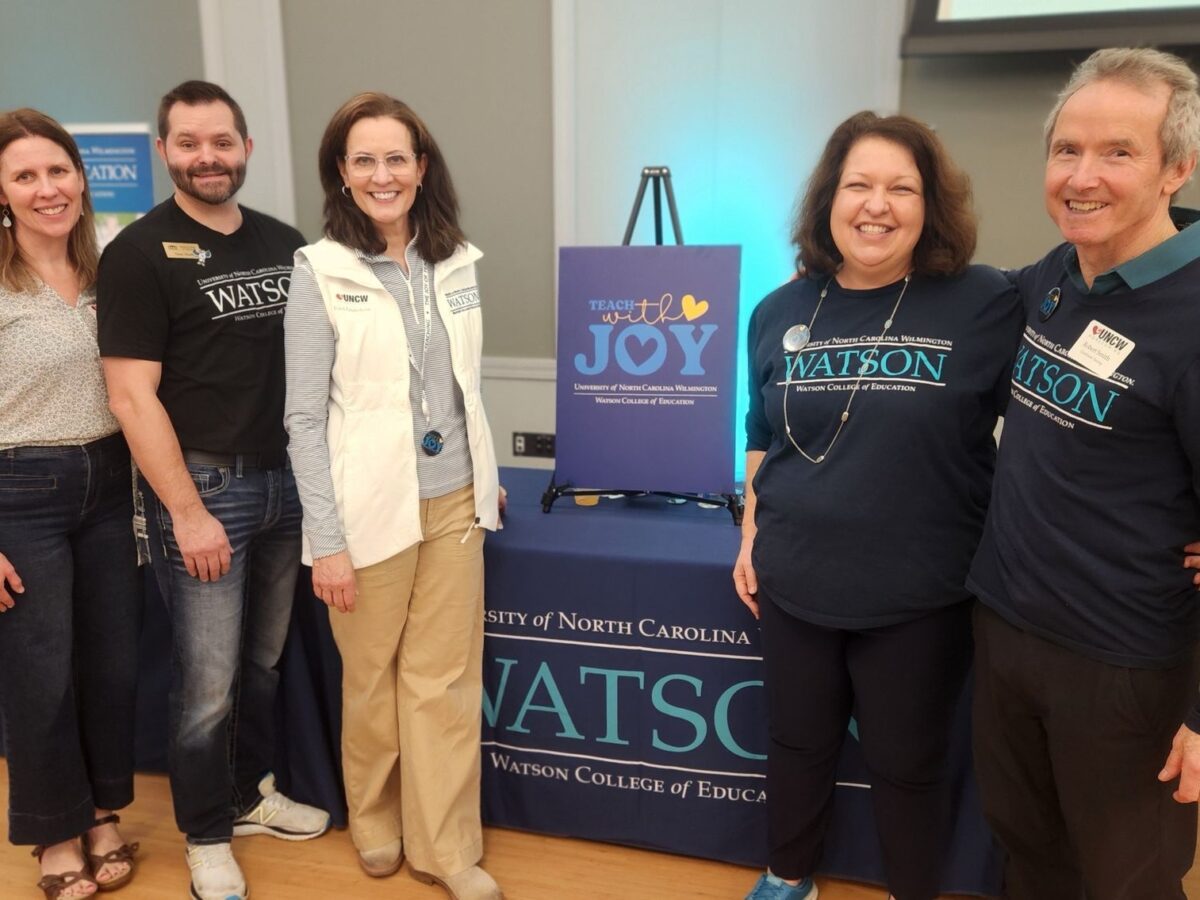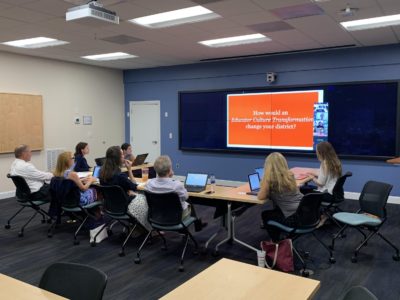
|
|
When I, Robert Smith, went for a routine observation of one of the UNCW teaching interns, I did not expect to be astonished by the joy that that brand-new teacher showed in his work.
Immediately after the observation, I wrote to my colleagues, “In all my years of supervising interns, Matt is the first one that shows joy in teaching. I have looked at our interns’ caring, enthusiasm, and welcoming, but until now, I never had joy on my radar. And there is no teaching standard for teaching with joy!”
What do we mean by “teaching with joy?”
Let me answer by describing what I saw in Matt’s class. I saw joy in teaching in Matt’s disposition, his relaxed demeanor and smile, his relationship with students, students’ engagement in learning, and his classroom, which displayed and celebrated students’ work.
It was clear that Matt enjoyed teaching the students in this US History class. He was comfortable, confident, relaxed and upbeat. He welcomed and chatted with students as they entered the room and as he walked around the room. He occasionally laughed with students. He called students by their names and offered praise to individual students for their participation as well as to the whole class. He was caring, supportive, and respectful of students, and they likewise respected him. When he told students that their phones should be away for the duration of his lecture and later noted “some of you have ears blocked,” students followed through.
Students were seated at tables as they worked on their main assignment, a 1920s magazine project in which they had to interpret and analyze key political and economic events. Even though students worked individually on the assignment, their proximity allowed them to talk comfortably with peers about their projects as well as to occasionally socialize. Nearly all students were fully engaged in their project, finding images to convey the main events of the time, deciding what information to include, and arranging the overall layout of their magazine. The assignment offered them a creative way to demonstrate their learning. In the background 80s music played and Matt and a few students occasionally joined in on the chorus. There was a positive hum to the class with both teacher and students caught up in learning.
In my post-conference with Matt, I spoke with him about this unique experience of seeing him teach with joy. He shared that he “worked both consciously and unconsciously to create a joyful environment in the classroom (music, relationships, jokes, etc.)” and that “most of his joy came from his own disposition and happiness to be there but also the joy my students brought to the room that helped make it a meaningful experience.”
Teaching with joy describes a teacher who genuinely enjoys being with students and appreciates the joy that they bring to the room, who can express that joy with students, who plans lessons that students enjoy and that engage them, and who creates a physical environment that reflects and values the students’ diverse contributions to the classroom community.
The observation sparked several in-depth and inspiring conversations with Denise Ousley about teaching with joy, including whether we teach with joy. That discussion has stimulated a lot of personal reflection on the way we experience, create, and find joy in teaching.
A few months later, in the fall 2024, we co-created the Teaching with Joy Network for high school teachers at the Watson College of Education. This network is led by a group of seven high school teachers including three English, three social studies, and one science teacher.
Denise and I selected these seven teachers based on their teaching with joy. Six of the teachers we had worked with closely and knew them well and the seventh was recommended by a colleague. We intentionally included teachers with a mix of years of experience — four who have taught for more than 15 years and three first-year teachers who graduated from our Secondary MAT program. We included first-year teachers who taught with joy, both because we believe that teaching with joy isn’t tied to years of experience, and also to help sustain the enthusiasm with which many beginning teachers enter teaching.
We created the network to provide an antidote to the challenges teachers are facing and specifically to help address the difficulties of recruiting and retaining teachers.
The Teaching with Joy Network currently includes:
- Jeremy Buie, Science, Ashley High
- Jessica Harvey, History, E. A. Laney High
- Sydney Hoover, English, North Brunswick High
- Kylee Maarschalk, English, New Hanover High
- Hannah Moon, English, E.A. Laney High
- Matt Taylor, Social Studies, Waynesboro High in Virginia
- Nicole Turner, Social Studies, Eugene Ashley High
We want to offer a message of hope and purpose in being a teacher and to reframe teaching as a valuable, uplifting, and desirable profession. Specific goals include:
- Create more welcoming, engaging, and exciting classrooms for students, and schools for teachers. This is a pressing issue, particularly for high schools with chronic absenteeism rates of 40%.
- Identify the teaching philosophy and practices associated with teaching with joy.
- Share the “Teaching with Joy Network” with other educators in Southeastern North Carolina and across North Carolina.
- Advocate for the conditions to support teaching with joy.
One of the main tasks we have been working on in our twice-monthly meetings is to describe what teaching with joy means for our network. In this exploration, we have valued the ideas of Gholdy Muhammad and Deonna Smith. While each member has a slightly different understanding or emphasis, we have identified the following core beliefs and practices:
- Teachers choose to teach with joy. It is an explicit practice. They choose it for themselves, their students, and their school.
- Relationships are at the core, with students feeling seen and valued. Teachers have compassion for students, understand the challenges they face, and see their potential.
- Teaching practices engage students and invite them into learning through student voice, choice, creativity, and collaboration.
- Classrooms, in physical and social spaces, are welcoming, supportive, collaborative, and celebrate students’ learning.
Although our network has only been in existence for a few months and is still getting off the ground, we have been excited with the level of interest from teachers and education leaders, including Dean Tracy Linderholm.
We started small with a focus on high school but realized that teachers of all grade levels should be included. We are planning ways to share the ideas and practices of teaching with joy, and how to expand the network in a manageable way.
Bigger questions include how to incorporate teaching with joy into preservice teacher education and, beyond that, how teaching with joy impacts administrators and administrator preparation, both in supporting these practices, but also, potentially in how administrators lead.
We hope that the Teaching with Joy Network can help provide educators with the support they deserve, reframing teaching as a joyful, valuable, and uplifting profession.
If you are interested in learning more about the Teaching with Joy Network, please contact Robert Smith at smithrw at uncw.edu or Denise Ousley at ousleyd at uncw.edu.
Recommended reading





